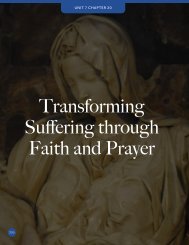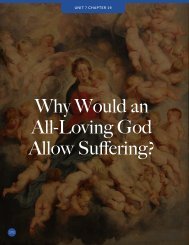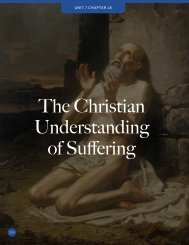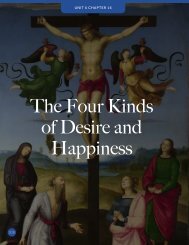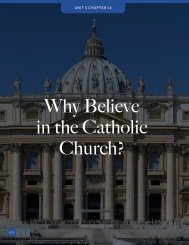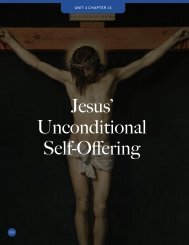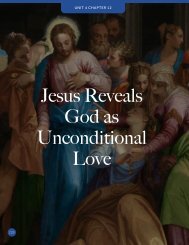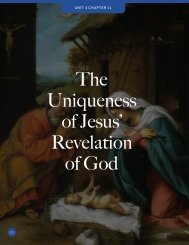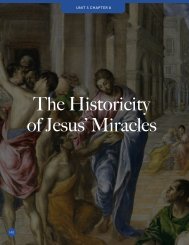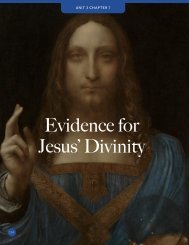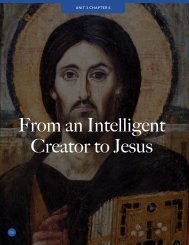CFS-WB-CH10
Create successful ePaper yourself
Turn your PDF publications into a flip-book with our unique Google optimized e-Paper software.
UNIT 3 CHAPTER 10<br />
Jesus Is with Us:<br />
Mary, the Saints,<br />
and the Eucharist<br />
188
Chapter 10 Overview<br />
You have learned in this unit about the miracles Jesus performed, as well as those done in His name.<br />
Throughout Church history, these miracles have been complemented by those connected with apparitions of<br />
Jesus’ Mother, the intercession of saints, and Eucharistic miracles.<br />
In this chapter you will learn that …<br />
■ Throughout the history of the Church, many miracles have been associated with apparitions of Mary, the<br />
intercession of the saints, and the Holy Eucharist.<br />
■ Contrary to popular belief, miracles are not a total suspension of the physical laws of science; though<br />
inexplicable, they are supernatural causes or events introduced by God into the natural patterns of<br />
nature.<br />
■ While there are many accounts of Our Lady appearing to the faithful in the history of the Church, the<br />
Church applies four specific criteria before approving Marian apparitions as valid.<br />
■ In the 20th and 21st centuries there have been many well-documented and scientifically confirmed<br />
miracles that occurred in connection with the canonization of well-known saints, and a number that<br />
manifest the Real Presence of Our Lord in the Eucharist.<br />
■ In a world largely governed by a materialistic view of reality, miracles validate the truth of God’s presence,<br />
goodness, and love for us.<br />
Bible Basics<br />
And a great portent appeared in heaven, a<br />
woman clothed with the sun, with the moon<br />
under her feet, and on her head a crown of<br />
twelve stars...<br />
—Revelation 12:1<br />
Connections to the Catechism<br />
■ CCC 963–966<br />
■ CCC 1373–1375<br />
■ CCC 2683–2684<br />
And he took bread, and when he had given<br />
thanks he broke it and gave it to them, saying,<br />
“This is my body which is given for you. Do this<br />
in remembrance of me.”<br />
— Luke 22:19<br />
© Sophia Institute for Teachers<br />
189
Chapter 10<br />
Aa<br />
VOCABULARY<br />
Marian Apparitions: Places<br />
and times when Mary<br />
appeared to bring the<br />
message of her Son, Jesus,<br />
after she was assumed into<br />
Heaven.<br />
Miracles Associated with Mary, Saints, and the<br />
Holy Eucharist<br />
In Chapter 8, we mentioned that there were thousands of miracles associated<br />
with the Risen Jesus (done in His name). Throughout the history<br />
of the Church, these miracles have been complemented by those<br />
connected with apparitions of His Mother, the intercession of saints,<br />
and Eucharistic miracles. We will review several well-documented and<br />
scientifically tested miracles in this chapter. Such miracles help show<br />
that the Risen Jesus is still powerfully present in our age — manifesting<br />
Himself in ways that are open to scientific and medical testing.<br />
People sometimes think miracles require suspension of inviolable<br />
physical laws — in other words, believing in miracles requires accepting<br />
that God is somehow breaking the laws of science. But miracles can<br />
be seen as much more orderly interventions: God is simply introducing<br />
transphysical (supernatural) causes and events into the natural patterns<br />
of physical nature, just like the author of a play might introduce a new<br />
line of dialogue. In fact, many scientists view the complexity and regularity<br />
of nature’s laws (and the mind’s power to grasp such laws) as itself<br />
miraculous, indicating the presence of the same divine intellect that<br />
shows itself in the rare interventions that we commonly call miracles.<br />
Three Marian Apparitions<br />
The Church is quite careful about approving Marian apparitions as valid<br />
— in the past 500 years, there have only been nine approved apparitions.<br />
Approval requires four criteria:<br />
1. Moral certainty or great probability that something miraculous has<br />
occurred (i.e. it cannot be explained by natural causes or fakery).<br />
2. The person(s) receiving the alleged revelation must be mentally<br />
sound, honest, of upright conduct, and obedient to Church<br />
authority.<br />
3. The content of the revelation must be theologically and morally<br />
sound, and free of error.<br />
4. The apparition must yield consistent spiritual benefits: such as<br />
conversion and prayer.<br />
Let us now look at three notable apparitions that received this<br />
approval.<br />
190 Apologetics I: The Catholic Faith and Science<br />
© Magis Center
The Apparition of Our Lady of Guadalupe<br />
In 1531, the Spanish bishop of Mexico City was visited by a native Aztec<br />
named Juan Diego, who claimed that the Virgin Mary had appeared to<br />
him and told him to ask the local bishop to build a church on Tepayac<br />
Hill. Skeptical, the bishop told Juan Diego to request a miraculous sign<br />
as proof of this apparition. When Juan Diego returned, he told the<br />
The image on St. Juan Diego’s<br />
tilma, still on display today, has<br />
many extraordinary attributes.<br />
Miraculous Image of the Virgin of Guadalupe..<br />
© Sophia Institute for Teachers<br />
Unit 3, Chapter 10: Jesus Is with Us: Mary, the Saints, and the Eucharist<br />
191
ishop that the Virgin had sent him to Tepayac Hill where he would find<br />
the bishop’s sign. He dramatically opened his cloak (or tilma) to reveal<br />
the Spanish roses (not native to Mexico) that he had found growing on<br />
the hill. The more striking sign, however, was on the tilma itself, which<br />
was imprinted with an image of the Virgin who had appeared to Juan.<br />
Bishop Zumarraga was convinced of truth of the Virgin’s appearance to<br />
Juan Diego and built the church. The image, still on display today, has<br />
many extraordinary attributes:<br />
1. The tilma is still intact — the cloak is still structurally sound almost<br />
500 years later. Most garments of this kind disintegrate within 15<br />
years.<br />
2. The image of the Virgin was not painted — no brush strokes,<br />
sketches, or corrections are detectable. It appears to have<br />
been produced in a single step, according to analysis by NASA<br />
consultant Dr. Philip Callahan.<br />
The tilma is on display today<br />
at the Virgin of Guadalupe<br />
Basilica, the most visited<br />
Catholic shrine of the<br />
Americas.<br />
3. The image was not produced by any known pigment — animal,<br />
mineral or vegetable — according to analysis by Nobel Prizewinning<br />
biochemist Richard Kuhn.<br />
4. Like the tilma, the original image is still intact after almost 500<br />
years. The paint and gold leaf added onto the image in later years<br />
has cracked and flaked, but, inexplicably, the image itself has not.<br />
Alamy stock photo.<br />
192 Apologetics I: The Catholic Faith and Science<br />
© Magis Center
5. The Virgin’s eyes in the image exhibit scientifically accurate<br />
details — the curvature of the cornea, the Purkinje-Sanson effect<br />
(a triple reflection of an object or objects seen in a person’s eye,<br />
one of which is inverted, even a reflection of what the Virgin<br />
would have seen, such as the bishop and others present in the<br />
room when the tilma was unveiled) that would be difficult for any<br />
contemporary photographer and computer imager to produce,<br />
let alone an artist in 1531, to reproduce.<br />
Other miracles have been associated with the image over the centuries,<br />
including several healings and a remarkable incident in 1921 when<br />
a bomb detonated underneath the tilma yet failed to damage it (even<br />
though the explosion was strong enough to bend a brass crucifix nearby).<br />
Finally, the appearance of Our Lady of Guadalupe in 16th century<br />
Mexico carries an enduring spiritual and cultural significance. Our<br />
Lady’s appearance to St. Juan Diego caused the conversion of more<br />
than nine million people native to the Americas and many Spaniards<br />
within a decade of her appearance. Her message of love and affection<br />
of the native people of the Western Hemisphere still resonates to this<br />
day, and she is now considered to be the patroness of all the Americas.<br />
Juan Diego was canonized a saint by Pope St. John Paul II in 2002.<br />
The Apparition of Our Lady of Lourdes<br />
The appearance of the Blessed Virgin Mary to Bernadette Soubirous at<br />
the Grotto of Lourdes in 1858 is probably the most well-known Marian<br />
apparition in history — not so much because of the apparition itself<br />
as the thousands of miraculous cures that have taken place through<br />
the water of the Grotto. On February 11 of that year, the 14-year-old<br />
Bernadette first saw the lady dressed in white with a blue sash, holding<br />
a golden Rosary. Speechless and scared, Bernadette was calmed<br />
when the lady invited her to pray the Rosary with her. Bernadette continued<br />
to see the lady several times between February and June, drawing<br />
rapidly growing crowds (especially after the lady revealed a spring<br />
whose waters produced many inexplicable medical healings). Alarmed<br />
by this runaway popularity, the state authorities briefly boarded up the<br />
grotto before bowing to popular pressure, and Church authorities convened<br />
a committee to assess the veracity of Bernadette’s apparitions.<br />
The apparition was judged authentic in January 1860, and Bernadette,<br />
who entered religious life after her experience, was canonized a saint in<br />
1933 by Pope Pius XI. Today, almost five million pilgrims per year visit<br />
the shrine at Lourdes, and hundreds receive extraordinary and miraculous<br />
cures.<br />
Our Lady’s<br />
appearance<br />
to St. Juan<br />
Diego caused<br />
the conversion<br />
of more than<br />
nine million<br />
people native<br />
to the Americas<br />
and many<br />
Spaniards within<br />
a decade of her<br />
appearance.<br />
© Sophia Institute for Teachers<br />
Unit 3, Chapter 10: Jesus Is with Us: Mary, the Saints, and the Eucharist<br />
193
There have been so many miraculous cures reported at Lourdes<br />
that a commission of doctors and scientists was established to evaluate<br />
such reports. Since 1905, the Lourdes Medical Bureau has recognized<br />
70 documented cures as definitively miraculous according to the seven<br />
Lambertini criteria, among which are — the cure happened instantaneously,<br />
endured throughout life, was scientifically inexplicable, had<br />
perfect documentation before and after, and virtually no medical treatment<br />
of any kind prior to the cure. Additionally, the Lourdes Medical<br />
Bureau has documented over 7,000 scientifically inexplicable cures,<br />
but any small deviation from the Lambertini criteria, such as receiving<br />
prior unsuccessful medical treatment, disqualified them from definitive<br />
recognition. All the bureau’s cases are open to review, and information<br />
can be found online. Right now, we will look at three of these cases.<br />
1. MARIE BAILLY AND ALEXIS CARREL (1902)<br />
The cure of Marie Bailly was witnessed by the physician Dr. Alexis Carrel<br />
(who would go on to win the Nobel Prize in 1912 for his innovations in<br />
vascular surgery). Marie Bailly suffered from acute tuberculous peritonitis,<br />
which visibly distended her abdomen with large hard masses<br />
and crippled her with pain. At the spring of Lourdes, three pitchers of<br />
water were poured over her abdomen, at which point, according to Dr.<br />
Carrel’s notes, “The enormously distended and very hard abdomen began<br />
to flatten and within 30 minutes it had completely disappeared.”<br />
Marie’s pain was gone, and she went on to live an active life working with<br />
the sick and the poor as a Sister of Charity. The dramatic, instantaneous<br />
cure made international headlines. Dr. Carrel was previously an agnostic<br />
and skeptic who hesitated to affirm the existence of miracles, but<br />
based on what he had seen, he was drawn to keep visiting Lourdes over<br />
the years. Eventually, he was moved to recognize the existence of God<br />
and the soul, and he entered the Catholic Church.<br />
2. GABRIEL GARGAM (1901)<br />
Gabriel Gargam was thrown 52 feet when the train he was riding in collided<br />
head on with another train traveling at 50 mph. After eight months,<br />
his injuries had brought him to death’s door. A mere 78 pounds with gangrenous<br />
feet, Gabriel could only eat once a day through a feeding tube.<br />
His Catholic relatives prevailed on him to visit Lourdes, but in his condition,<br />
the strain of the trip itself nearly killed him. In fact, he blacked out<br />
when he was brought to the waters, and the attendants believed him to<br />
be dead. They covered his face and placed him in a carriage, but on the<br />
way back to the hotel, the carriage encountered a passing Eucharistic<br />
194 Apologetics I: The Catholic Faith and Science<br />
© Magis Center
procession, and the bishop gave him a Eucharistic blessing. Gabriel<br />
then sat up under his own power and even got out of the carriage to<br />
walk around. The entire crowd, including physicians, was astonished. On<br />
August 20, 1901, he was examined by 63 physicians, all of whom pronounced<br />
him completely cured. Before the cure Gabriel’s leg muscles<br />
were completely atrophied and his stomach and vocal cords were dysfunctional.<br />
Within seconds of receiving the Eucharist blessing, his leg<br />
muscles grew back to normal size and strength and his stomach and vocal<br />
cords were perfectly restored. No physical cause could be explained,<br />
then or now, for the cure.<br />
3. JOHN TRAYNOR (1923)<br />
A paralyzed right arm with atrophied muscles, partially paralyzed legs,<br />
daily epileptic fits, and a permanent hole in the skull — John Traynor’s<br />
injuries from machine gun fire in World War I were enough to persuade<br />
Since 1905, Lourdes Medical<br />
Bureau has found 70 healings<br />
to be without medical or<br />
scientific explanation.<br />
Healing Procession at Lourdes, Stained glass from the church of Nuestra<br />
Señora de Covadonga in Mexico City. Image courtesy Lawrence, OP.<br />
© Sophia Institute for Teachers<br />
Unit 3, Chapter 10: Jesus Is with Us: Mary, the Saints, and the Eucharist<br />
195
The miracle of the sun was<br />
witnessed by over 50,000<br />
people, including the tens of<br />
thousands who had gathered,<br />
and others as far as 40km<br />
away, who had no expectation<br />
of seeing anything.<br />
Some of those looking at the Miracle of the Sun<br />
at Fatima, Portugal, 13 October 1917.<br />
everyone that a trip to Lourdes would kill him. They were almost right.<br />
But on his tenth outing at the spring’s baths, he felt his legs stir, and immediately<br />
after a blessing with the Eucharist, his atrophied arm (paralyzed<br />
for eight years) became strong enough that he could burst<br />
through his bandages, and he stood up and began to walk. His attendants<br />
put him to bed, fearing he might hurt himself, but he got up in the<br />
middle of the night and ran back to the Grotto to pray. So complete was<br />
Traynor’s transformation (even the hole in the skull was closed) that<br />
he went into the coal and hauling business, routinely lifting 200-pound<br />
sacks. In 1926, the Lourdes Medical Bureau certified that all Traynor’s<br />
injuries had been instantly and permanently cured in a scientifically inexplicable<br />
way.<br />
The many miraculous healings at Lourdes indicate the divine power<br />
working in the world, and more specifically point to God’s love. Even<br />
those pilgrims who do not receive physical healing at Lourdes often report<br />
spiritual renewal. They return to their lives aware of God’s loving<br />
presence, helping them with whatever crosses they must bear on the<br />
path to eternal life.<br />
Just as Mary’s appearance at Guadalupe showed her motherly care<br />
for St. Juan Diego and the people of the Americas, her appearance at<br />
the healing site of Lourdes brings that same motherly care to the afflicted<br />
of our own modern age.<br />
196 Apologetics I: The Catholic Faith and Science<br />
© Magis Center
Some people avoid a relationship with Mary out of concern to avoid<br />
idolizing her. While we certainly want to avoid worshiping Mary, we<br />
should not fear appreciating her vital role in the order of salvation. When<br />
the Father made all of us adopted children through His Son Jesus, He<br />
also made us adopted children of Jesus’ mother Mary. She accepts us<br />
within the divine-human family she initiated through her consent to be<br />
the mother of His Son. We are her children — not just in the first century<br />
— but for all time — and the miracles of Guadalupe and Lourdes confirm<br />
this logic of familial love.<br />
The Apparition of Our Lady of Fatima<br />
In the spring of 1916, three Portuguese shepherd children — Lucia<br />
Santos and her cousins, Jacinta and Francisco Marto, were visited three<br />
times by an angel who identified himself as “The Angel of Peace.” The<br />
angel taught them prayers and encouraged them to spend time in<br />
Adoration. On May 13, 1917, the children were visited for the first time by<br />
the Blessed Virgin Mary at the Cova da Iria in Fatima, who appeared to<br />
them as exceedingly radiant. She wore a white mantle edged with gold,<br />
carried a Rosary, and told the children to devote themselves to the Holy<br />
Trinity and to daily recitation of the Rosary for an end to the First World<br />
War. The visions continued monthly until the final apparition on October<br />
13, 1917, at which Mary had previously promised an extraordinary miracle<br />
would occur.<br />
About 50,000 people had gathered to witness this promised miracle.<br />
It had been raining and then it began to clear. Lucia shouted, “Look<br />
at the sun.” The sun appeared to be rotating on its own axis and throwing<br />
out a variety of colors. It then appeared to approach the earth,<br />
causing many in the crowd to believe the world was ending. It then returned<br />
to its normal state. Though the ground had been quite wet from<br />
the rain prior to the miracle, the sun’s activity during the miracle dried<br />
the ground significantly, baffling many of the engineers and scientists<br />
present. (The amount of energy required for this would be extraordinary.)<br />
The miracle was variously described by reporters, doctors, and<br />
scientists, including three books of research assembled by Fr. John<br />
DeMarchi. The phenomenon was witnessed by people within a 40 km<br />
radius of the site, which is too narrow an area for an astronomical explanation<br />
(the whole world would have noticed if the sun itself was moving)<br />
and too wide an area for a mass hallucination explanation (some of<br />
the witnesses were miles away from the crowd and had no expectation<br />
of seeing anything).<br />
© Sophia Institute for Teachers<br />
Unit 3, Chapter 10: Jesus Is with Us: Mary, the Saints, and the Eucharist<br />
197
Canonization: Declaration<br />
by the Catholic Church that<br />
a beatified soul is a saint.<br />
Two miracles credited to<br />
the person’s intercession<br />
are usually required before<br />
canonization.<br />
Ultimately, whether the event was produced by a convergence of<br />
highly unusual atmospheric factors (at a time and place somehow predicted<br />
months in advance by Lucia) or had a purely supernatural cause<br />
(such as a transphysical spinning lens or prism), it seems reasonable<br />
to conclude the presence of supernatural power. The miracle serves<br />
to verify the apparition and Our Lady’s message of prayer for world<br />
peace. Francisco and Jacinta, who died in 1919 and 1920 respectively,<br />
were canonized saints by Pope Francis in 2017. Lucia would later enter<br />
religious life as a Carmelite nun and lived until 2005. The cause for her<br />
canonization was opened in 2008, and she was declared a Servant of<br />
God (the first step in the process of sainthood) in 2017.<br />
Validated Miracles through the Intercession of<br />
Contemporary Saints<br />
There are many miracles from the 20th and 21st centuries that occurred<br />
in connection with the canonization of well-known saints that<br />
have been well-documented and scientifically confirmed by objective<br />
scientific panels. (Two documented, scientifically verified miracles are<br />
required before sainthood is declared.) When we consider that Pope<br />
Saint John Paul II, Pope Benedict XVI, and Pope Francis have canonized<br />
1,375 saints, it means that, as of 2022, in the last 45 years, the Church<br />
has scientifically documented 2,750 miracles pertaining to saints alone.<br />
Here is one example.<br />
A Miracle Attributed to Ven. Fulton J. Sheen<br />
Bonnie and Travis Engstrom were at home for the birth of their son James<br />
in September 2010. When the baby emerged, he was pulseless, his arms<br />
and legs flopped to the side, and he was blue in color. They discovered<br />
that his umbilical cord had become knotted during delivery, cutting off<br />
blood, oxygen and nutrition to the baby during the delivery process. The<br />
midwife and others urgently performed CPR during the 20-minute wait<br />
for the ambulance, but at the hospital, doctors could not resuscitate the<br />
baby, and after 61 minutes without breathing, were about to declare him<br />
deceased. Throughout the ordeal, the parents and friends had prayed<br />
through the intercession of Archbishop Fulton Sheen, and just as death<br />
was about to be called, James’ heart began to beat normally. Despite<br />
the hour of cardiac arrest and massive oxygen deprivation.<br />
James Fulton Engstrom did not go on to manifest the organ failure,<br />
brain damage, or numerous other disabilities expected. He would grow<br />
up as a normal healthy child. A panel of medical specialists concluded<br />
that this recovery could not be explained by scientifically known causes.<br />
198 Apologetics I: The Catholic Faith and Science<br />
© Magis Center
Image courtesy Paralacre.<br />
Two Contemporary Scientifically Verified Eucharistic<br />
Miracles<br />
The act of transubstantiation is itself miraculous, but the term<br />
Eucharistic miracle usually refers to rare external signs of Jesus’ presence<br />
in the Eucharist — most notably bleeding hosts, or the transmutation<br />
of a consecrated host into a piece of cardiac (heart) muscle<br />
tissue. Usually, it is difficult to preserve the chain of evidence to certify<br />
such miracles, but two opportunities have come in the dioceses of<br />
Buenos Aires in 1996 and Sokolka, Poland in 2008.<br />
Crowds of the faithful wait<br />
in St. Peter’s Square for the<br />
Canonization of Pope John<br />
XXIII and Pope John Paul II.<br />
BUENOS AIRES, 1996<br />
A consecrated host was found desecrated at the Church of Santa<br />
Maria y Caballito Almagro in Buenos Aires, Argentina. Fr. Alejandro<br />
Pezet placed the host in a glass of water to dissolve (the customary<br />
practice in such cases) and left it in the tabernacle. When Fr.<br />
Pezet opened the tabernacle a week later, he found that the host<br />
had been transformed into a piece of bloody tissue which was larger<br />
© Sophia Institute for Teachers<br />
Unit 3, Chapter 10: Jesus Is with Us: Mary, the Saints, and the Eucharist<br />
199
Scientists in a New York<br />
lab (who did not know the<br />
true source of the sample)<br />
analyzed the tissue and<br />
concluded it was a fragment of<br />
heart muscle which had been<br />
taken from a living man who<br />
had type AB blood.<br />
Image courtesy Junior.<br />
than the original host. He notified Archbishop Bergoglio (the future<br />
Pope Francis), who asked him to have the host professionally photographed.<br />
It was decided to keep the host in the tabernacle without<br />
any publicity.<br />
After three years, the bloody tissue — unaccountably — had not<br />
decomposed. Archbishop Bergoglio asked that the tissue be scientifically<br />
examined, and it was sent to a scientific committee in New<br />
York (whose members were not told of the source). The histopathological<br />
examination — a medical examination of tissues — determined<br />
the sample was a fragment of heart muscle taken from the left<br />
ventricle.<br />
White blood cells were present (indicating the heart was alive<br />
when the tissue fragment was taken) and embedded in the tissue (indicating<br />
great stress to the heart, as from the person’s chest being<br />
severely beaten). Note that the presence of white blood cells requires<br />
that the tissue have been taken while the person was alive. The blood<br />
type was AB positive, consistent with blood samples from both the<br />
200 Apologetics I: The Catholic Faith and Science<br />
© Magis Center
Shroud of Turin and the Facecloth of Oviedo. The moral and logistical<br />
barriers to taking a tissue sample that meets these criteria and keeping<br />
it intact for three years in an ordinary tabernacle would certainly<br />
seem to point to a Eucharistic miracle. It can scarcely be imagined that<br />
the Church would torture a person, then surgically remove a piece of<br />
the left ventricle wall (while he was still alive, and which would have ultimately<br />
killed him) in order to fake a Eucharistic miracle. Inasmuch as<br />
this is out of the question, then the appearance of that tissue in place<br />
of the Eucharistic host would seem to be a miracle manifesting the<br />
Real Presence of Jesus in the Holy Eucharist.<br />
SOKOLKA, POLAND, 2008<br />
On Sunday, October 12, 2008, during a Mass at St. Anthony’s Church in<br />
Sokolka, Poland, a Eucharistic host was dropped by the pastor during<br />
the distribution of Communion. The pastor had the host put into some<br />
water to dissolve it, and then put it into a safe. When the host was<br />
checked one week later, it was found to have blood and what seemed<br />
to be tissue growing out of it.<br />
The archbishop then requested that histopathological studies<br />
be done. On March 30, 2009, the archbishop appointed an ecclesial<br />
commission to study the host because it had not deteriorated over<br />
several months, and research was done at the Medical University of<br />
Bialystok.<br />
The results of the histopathological tests were remarkable. The<br />
tissue part of the host was found to be cardiac tissue, which was completely<br />
integrated into the bread part of the host so seamlessly that<br />
it appeared to be growing out of the bread itself. During the analysis<br />
with the electron microscope, the outlines of the communicating<br />
junctions and the thin filaments of the myofibrils were visible, showing<br />
that the cardiac tissue was joined to the consecrated Host in an<br />
inseparable manner. Indeed, the analysis showed that the integration<br />
of the two substances could not be produced by any known human<br />
technology. According to one of the researchers, “Even NASA scientists,<br />
who have at their disposal the most modern analytical techniques,<br />
would not be able to artificially recreate such a thing.” Further<br />
analysis disclosed that the structure of the transformed tissue part of<br />
the host was identical to the myocardial (heart) tissue of a living person<br />
who was nearing death. Even more, the heart tissue was still alive<br />
and came from the upper left ventricle with living white blood cells<br />
performing activities to control infection. The studies proved that no<br />
foreign substance was added to the consecrated host. Rather, part of<br />
© Sophia Institute for Teachers<br />
Unit 3, Chapter 10: Jesus Is with Us: Mary, the Saints, and the Eucharist<br />
201
The miraculously transformed<br />
host in Sokolka, Poland was<br />
placed on a small corporal,<br />
and is now displayed in a<br />
monstrance. Two independent<br />
studies concluded that the<br />
structure of the transformed<br />
fragment of the host is<br />
identical to the myocardial<br />
(heart) tissue of a living<br />
person nearing death.<br />
Image courtesy of St. Anthony of Padua in Sokolka, Poland.<br />
the host became heart muscle of a person near death. This kind of<br />
phenomenon is inexplicable by the natural sciences.<br />
There are numerous other Eucharistic miracles from around the<br />
world, including one from 2006 in Tixtla, Mexico, which is equally<br />
well-documented scientifically. When the evidence of these miraculous<br />
hosts is combined, it demonstrates not only supernatural power,<br />
but also the Real Presence of Christ in the Eucharist.<br />
Conclusion<br />
The above three Marian apparitions (and the miracles associated with<br />
them), the intercessory miracles of the saints, and the two Eucharistic<br />
miracles are but a very small sample of miracles from throughout the<br />
centuries and even today. They are recounted here because they<br />
have been subject to considerable scientific scrutiny by experts who<br />
are believers and non-believers. Such miracles not only help give credence<br />
to the Christian Faith, the Risen Jesus, and His Real Presence in<br />
the Eucharist, but also ground the rich theology of the Blessed Virgin<br />
202 Apologetics I: The Catholic Faith and Science<br />
© Magis Center
Mary and the saints that constitute the mystical body and the living<br />
tradition of the Catholic Church. Our interactions with Mary and the<br />
saints help us experience God’s love and goodness, just as we often<br />
experience God’s love and goodness through the kindness and beauty<br />
of our friends and family in our communities.<br />
As we contemplate the life of the Virgin Mary and include her in our<br />
prayers — and further contemplate the lives of the saints, in their goodness,<br />
holiness and love — we put a prism in front of the light of God’s glory<br />
making it a myriad of interwoven colors and shapes — a veritable symphony<br />
of holiness and love. The miracles studied in this chapter not only<br />
serve to validate this view of God, but also reveal the same beauty that<br />
they validate. Miracles — scientifically and naturally inexplicable events<br />
occurring through apparitions and prayer — validate the truth of God’s<br />
presence, goodness, and love. They fill us with wonder, awe, fascination,<br />
and delight — the very thing lacking in a purely mundane materialistic<br />
view of reality. If we are to enjoy their richness to the full, we will also want<br />
to practice devotion to the Blessed Virgin Mary (through the Rosary)<br />
and allow ourselves to be moved by lives of the saints, who reflect the<br />
glory and grandeur of God. Above all, we will want to have particular devotion<br />
to the Holy Eucharist, which is the Real Presence of Jesus’ Body<br />
and Blood miraculously manifest through the Catholic Church He initiated<br />
nearly 2,000 years ago (a topic we will explore in Unit 5).<br />
But what are we to conclude about the question with which we<br />
began this unit? Is Jesus Emmanuel, “God with us?” Is Jesus who He<br />
claimed to be?<br />
The heart of Jesus’ message during His earthly life is that He is the<br />
Son of God, that God is unconditional love, and that He, as the Son of<br />
God, is also unconditional love. These claims give us a remarkable internal<br />
validation. For if He really is the Son of God as He claimed, then He would<br />
have made an unconditionally loving self-sacrifice to be with us and reveal<br />
Himself to us. This is perfectly consistent with what He says about<br />
Himself and His Father. Jesus’ words are consistent with who He is.<br />
Jesus gave us external proofs of His Divinity such as His Resurrection<br />
in glory, His gift of the Holy Spirit, and His miracles by His own authority.<br />
He also gives, as we will learn about in the next unit, certain external validations<br />
that He is unconditional love as well. When we put together all<br />
the pieces of the puzzle, we can conclude reasonably and responsibly<br />
that Jesus is the unconditionally loving Son of God, Emmanuel (“God<br />
with us”). In other words, Jesus is who He said He was. We must, however,<br />
be moved to this conclusion in our hearts as well in order to come to<br />
faith, which is a topic we will explore further in the next unit.<br />
The heart of<br />
Jesus’ message<br />
during His<br />
earthly life is<br />
that He is the<br />
Son of God,<br />
that God is<br />
unconditional<br />
love, and that<br />
He, as the Son<br />
of God, is also<br />
unconditional<br />
love.<br />
© Sophia Institute for Teachers<br />
Unit 3, Chapter 10: Jesus Is with Us: Mary, the Saints, and the Eucharist<br />
203
Focus and Reflection Questions<br />
1 What do well-documented and scientifically tested modern miracles help show?<br />
2 How can miracles be understood apart from suspending inviolable physical laws?<br />
3 What evidence indicates that the Church is careful about approving Marian apparitions? What<br />
criteria are required for approval?<br />
4 What is one extraordinary attribute of the tilma on which the image of of Our Lady of Guadalupe<br />
appears? How is it not explainable by natural causes?<br />
5 How does the apparition of Our Lady of Guadalupe fulfil the fourth criteria for an authentic<br />
apparition?<br />
6 Why is the Apparition of Our Lady of Lourdes one of the most well-known Marian apparitions in history?<br />
7 How many cures at Lourdes have been documented as definitively miraculous? What does<br />
definitively miraculous mean?<br />
8 What do Marian Apparitions teach us about Mary’s relationship with us?<br />
9 What did Mary tell the children at her appearances at Fatima?<br />
10 What extraordinary miracle occurred on October 13, 1917? How does this miracle defy both<br />
astronomical and psychological explanation?<br />
11 What role does scientific verification play in the canonization of saints?<br />
12 How do the medical miracles attributed to St. Padre Pio, Bl. Fulton Sheen, and Pope St. John Paul II<br />
defy scientific explanation?<br />
13 What miracle occurred to a desecrated Eucharistic host in 1996?<br />
14 What do the miracles studied in this chapter (and many others) accomplish regarding our faith? How<br />
can we more fully enter into and enjoy the richness of the miracles of the Church?<br />
204 Apologetics I: The Catholic Faith and Science<br />
© Magis Center
Straight to the Source<br />
ADDITIONAL READINGS FROM PRIMARY SOURCES<br />
Homily of Pope Francis on the Feast of Our Lady of Guadalupe, December 12, 2014<br />
On this Feast of Our Lady of Guadalupe, let us first of all gratefully remember her visit and maternal<br />
closeness; let us sing her Magnificat with Her; and let us entrust the life of our peoples and the continental<br />
mission of the Church to her. When she appeared to St Juan Diego on the Hill of Tepeyac, she<br />
presented herself as the “ever perfect Holy Virgin Mary, Mother of the true God” (Nican Mopohua);<br />
and so made a new “visitation”. She also hastened attentively to embrace the new American peoples,<br />
at their dramatic birth. It was as though a “great portent appeared in heaven, a woman clothed with the<br />
sun, with the moon under her feet” (Rev 12:1), taking upon herself the cultural and religious symbolism<br />
of the indigenous peoples, she proclaimed and gave her Son to all these new peoples lacerated by their<br />
mixed origin.<br />
… The Holy Mother of God visited these peoples and has wished to remain with them. She mysteriously<br />
left her sacred image imprinted on the tilma [cloak] of her messenger so we would feel her constant<br />
presence, thereby becoming a symbol of Mary’s covenant with these peoples, to whom she imparts her<br />
soul and tenderness. Through her intercession, the Christian faith began to grow into the most precious<br />
treasure of the soul of the American peoples, whose pearl of great value is Jesus Christ: a patrimony<br />
that has been passed on and is manifest still today in the baptism of multitudes of people, in the faith,<br />
in hope and charity of many, in the preciosity of popular piety and also in the American ethos which is<br />
shown in the awareness of human dignity, in the passion for justice, in solidarity with the poorest and the<br />
suffering, in the hope, at times, against all hope.<br />
1 What does Pope Francis suggest was the reason for Mary to appear to the Native American people?<br />
2 How did Mary present herself to the indigenous people? How did she show that she would remain<br />
with them?<br />
3 What according to Pope Francis is the ‘American ethos?’<br />
Le Pelerinage de Lourdes 42, 45–47, 57–60, an Encyclical Letter of Pope Pius XII, July 2, 1957<br />
42. Only on condition of a return to regular reception of the sacraments, a regard for Christian morals<br />
in everyday life, entry into the ranks of Catholic Action and other apostolates recommended by the<br />
Church, can the great crowds expected to gather at Lourdes in 1958 yield - according to the expectations<br />
of the Immaculate Virgin herself - the fruits of salvation so necessary to mankind today.…<br />
45. But the world, which today affords so many justifiable reasons for pride and hope, is also undergoing<br />
a terrible temptation to materialism which has been denounced by Our Predecessors and Ourselves on<br />
many occasions.<br />
© Sophia Institute for Teachers<br />
Unit 3, Chapter 10: Jesus Is with Us: Mary, the Saints, and the Eucharist<br />
205
46. This materialism is not confined to that condemned philosophy which dictates the policies and<br />
economy of a large segment of mankind. It rages also in a love of money which creates ever greater<br />
havoc as modern enterprises expand, and which, unfortunately, determines many of the decisions<br />
which weigh heavy on the life of the people. It finds expression in the cult of the body, in excessive desire<br />
for comforts, and in flight from all the austerities of life. It encourages scorn for human life, even for<br />
life which is destroyed before seeing the light of day.<br />
47. This materialism is present in the unrestrained search for pleasure, which flaunts itself shamelessly<br />
and tries, through reading matter and entertainments, to seduce souls which are still pure. It shows itself<br />
in lack of interest in one’s brother, in selfishness which crushes him, in justice which deprives him of his<br />
rights - in a word, in that concept of life which regulates everything exclusively in terms of material prosperity<br />
and earthly satisfactions.…<br />
57. Go to her, you who are crushed by material misery, defenseless against the hardships of life and the<br />
indifference of men. Go to her, you who are assailed by sorrows and moral trials. Go to her, beloved invalids<br />
and infirm, you who are sincerely welcomed and honored at Lourdes as the suffering members of<br />
our Lord. Go to her and receive peace of heart, strength for your daily duties, joy for the sacrifice you<br />
offer.<br />
58. The Immaculate Virgin, who knows the secret ways by which grace operates in souls and the silent<br />
work of this supernatural leaven in this world, knows also the great price which God attaches to your<br />
sufferings united to those of the Savior. They can greatly contribute, We have no doubt, to this Christian<br />
renewal of society which We implore of God through the powerful intercession of His Mother.<br />
59. In response to the prayers of the sick, of the humble, of all the pilgrims to Lourdes, may Mary turn<br />
her maternal gaze upon those still outside the limits of the only fold, the Church, that they may come<br />
together in unity. May she look upon those who are in search, who are thirsty for truth, and lead them to<br />
the source of living waters.<br />
60. May she cast her glance upon the vast continents and their limitless human areas where Christ is<br />
unfortunately so little known, so little loved; and may she obtain for the Church freedom and the joy of<br />
being able to respond everywhere, always youthful, holy, and apostolic, to the longing of men.<br />
1 Pope Pius XII wrote this encyclical in honor of the 100th anniversary of Our Lady’s appearance to<br />
St. Bernadette in Lourdes. What conditions does he set, according to the expectations of the Virgin<br />
herself, for the yielding of the fruits of salvation?<br />
2 How would you define materialism according to the pope’s description in this encyclical?<br />
3 What prayer of intercession does the pope give to Mary, especially in her apparition at Lourdes?<br />
206 Apologetics I: The Catholic Faith and Science<br />
© Magis Center



